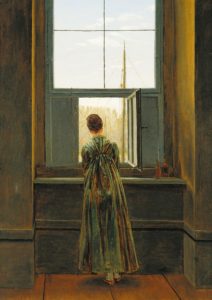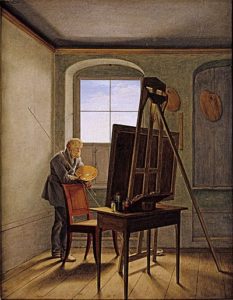
Caspar David Friedrich
For as long as there have been windows, artists have painted them. Think of Vermeer with the light streaming in, Matisse with his billowing curtains, Rembrandt with his peasants leaning out. Think of all the flowerpots and cats sitting on windowsills, all the charming rooftop and treetop scenes, or even those medieval miracle paintings with angels riding through windows on sunbeams.
And when it comes right down to it, doesn’t the window itself – a frame with an image in it — look like a painting?
In “Rooms with a View: The Open Window in the 19th Century,” the Metropolitan Museum of Art zeroes in on a period in art – German romanticism – when the window-motif seemed to resonate more than usual. Curator Sabine Rewald has rounded up 31 oil paintings and 26 works on paper to make her case that windows had a special poignancy for artists in the early to mid-1800s.
If the show has a hero, it’s Caspar David Friedrich. In his maturity, he became known for paintings of spiritual pilgrims pondering moonlit landscapes, alpine sunsets or other sublime vistas. We meet him earlier in his career, when, fresh out of art school, he moved to Dresden and settled into a studio with a view of the Elbe River. A few years later he made two sepia-wash drawings of his tall arched windows that nudged art history in a new direction.

Georg Friedrich Kersting
What was so special about them? Despite being only about a foot high, these simple, architecturally precise drawings feel large and expansive. There are few details inside or outside to detract from the basic facts of glass, wall, light and air. The narrow strip of river scenery is too pale, too subdued to be the point of the picture. Likewise for the dark, minimalist treatment of the interior room. What remains is the window, which, for the first time, was itself the subject of a picture.
What the romantics saw in these luminous windows was a yearning for something distant and ineffable, a metaphor for spiritual longing.
Friedrich’s act was a tough one to follow. His stark, stripped-down imagery didn’t leave much room for others to stake claims. Elaboration was the only direction left. Even Friedrich himself couldn’t recapture the existential force of his original inspiration. An oil painting of his wife made about 15 years later feels like a pleasant genre painting – a woman, seen from the back, gazing dreamily out of a window.
Other women, by other painters are also seen at windows here. All are charming. One braids her Rapunzel tresses. Another, fresh from her bed in her cozily decorated room, leans out the window to greet the new day. We see women sewing or spinning in the window light, absorbed in their work like the women in Vermeer paintings.
Other painters left figures out entirely, but, unlike Friedrich, couldn’t resist opening windows onto vivid little paradises with castles and gorgeous sunsets. A German artist named Carl Ludwig Kaaz didn’t like his own studio’s view, so used the more picturesque view from another painter’s studio. Still finding it less than ideal, he “italianized” it, turned the German scenery into what looks like a Giorgione landscape.

Georg Friedrich Kersting_
Windows seem to have been a popular motif with young French painters who had won the prestigious Prix de Rome. The award allowed them to spend five years at the Académie de France in the Villa Medici in Rome. As if composing snapshots to send home, they painted themselves settling into their room, bags on the chair, hat tossed on the bed. At the center of the picture is a window with a view of the poetic countryside – the campagna – that awaited them outside the Eternal City.
In a twist on the window-as-painting theme, a picture by an artist named Carl Gustav Carus shows a blank canvas propped up against a window frame, the working side facing out. What this about? As a studio practice, painters at that time were instructed to block out the light from the lower part of the window, so that the room would be lit only by the less direct light reflected off the upper sky.
And yet, in this context, it plays like a surrealist joke: the painting as a window on the world – except somebody forgot to turn it around.

